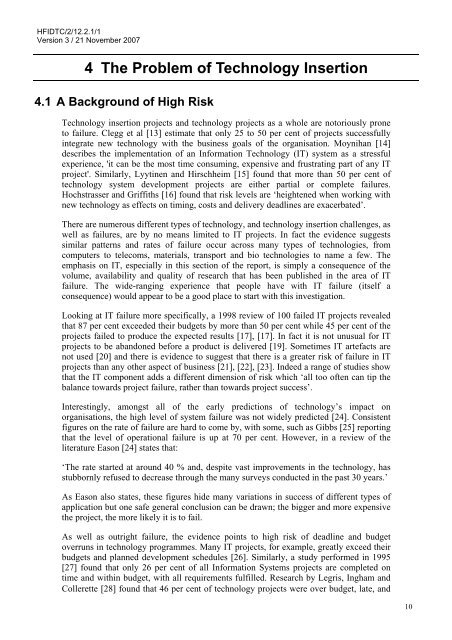The Impact of Technology Insertion on Organisations
The Impact of Technology Insertion on Organisations
The Impact of Technology Insertion on Organisations
Create successful ePaper yourself
Turn your PDF publications into a flip-book with our unique Google optimized e-Paper software.
HFIDTC/2/12.2.1/1<br />
Versi<strong>on</strong> 3 / 21 November 2007<br />
4 <str<strong>on</strong>g>The</str<strong>on</strong>g> Problem <str<strong>on</strong>g>of</str<strong>on</strong>g> <str<strong>on</strong>g>Technology</str<strong>on</strong>g> <str<strong>on</strong>g>Inserti<strong>on</strong></str<strong>on</strong>g><br />
4.1 A Background <str<strong>on</strong>g>of</str<strong>on</strong>g> High Risk<br />
<str<strong>on</strong>g>Technology</str<strong>on</strong>g> inserti<strong>on</strong> projects and technology projects as a whole are notoriously pr<strong>on</strong>e<br />
to failure. Clegg et al [13] estimate that <strong>on</strong>ly 25 to 50 per cent <str<strong>on</strong>g>of</str<strong>on</strong>g> projects successfully<br />
integrate new technology with the business goals <str<strong>on</strong>g>of</str<strong>on</strong>g> the organisati<strong>on</strong>. Moynihan [14]<br />
describes the implementati<strong>on</strong> <str<strong>on</strong>g>of</str<strong>on</strong>g> an Informati<strong>on</strong> <str<strong>on</strong>g>Technology</str<strong>on</strong>g> (IT) system as a stressful<br />
experience, 'it can be the most time c<strong>on</strong>suming, expensive and frustrating part <str<strong>on</strong>g>of</str<strong>on</strong>g> any IT<br />
project'. Similarly, Lyytinen and Hirschheim [15] found that more than 50 per cent <str<strong>on</strong>g>of</str<strong>on</strong>g><br />
technology system development projects are either partial or complete failures.<br />
Hochstrasser and Griffiths [16] found that risk levels are ‘heightened when working with<br />
new technology as effects <strong>on</strong> timing, costs and delivery deadlines are exacerbated’.<br />
<str<strong>on</strong>g>The</str<strong>on</strong>g>re are numerous different types <str<strong>on</strong>g>of</str<strong>on</strong>g> technology, and technology inserti<strong>on</strong> challenges, as<br />
well as failures, are by no means limited to IT projects. In fact the evidence suggests<br />
similar patterns and rates <str<strong>on</strong>g>of</str<strong>on</strong>g> failure occur across many types <str<strong>on</strong>g>of</str<strong>on</strong>g> technologies, from<br />
computers to telecoms, materials, transport and bio technologies to name a few. <str<strong>on</strong>g>The</str<strong>on</strong>g><br />
emphasis <strong>on</strong> IT, especially in this secti<strong>on</strong> <str<strong>on</strong>g>of</str<strong>on</strong>g> the report, is simply a c<strong>on</strong>sequence <str<strong>on</strong>g>of</str<strong>on</strong>g> the<br />
volume, availability and quality <str<strong>on</strong>g>of</str<strong>on</strong>g> research that has been published in the area <str<strong>on</strong>g>of</str<strong>on</strong>g> IT<br />
failure. <str<strong>on</strong>g>The</str<strong>on</strong>g> wide-ranging experience that people have with IT failure (itself a<br />
c<strong>on</strong>sequence) would appear to be a good place to start with this investigati<strong>on</strong>.<br />
Looking at IT failure more specifically, a 1998 review <str<strong>on</strong>g>of</str<strong>on</strong>g> 100 failed IT projects revealed<br />
that 87 per cent exceeded their budgets by more than 50 per cent while 45 per cent <str<strong>on</strong>g>of</str<strong>on</strong>g> the<br />
projects failed to produce the expected results [17], [17]. In fact it is not unusual for IT<br />
projects to be aband<strong>on</strong>ed before a product is delivered [19]. Sometimes IT artefacts are<br />
not used [20] and there is evidence to suggest that there is a greater risk <str<strong>on</strong>g>of</str<strong>on</strong>g> failure in IT<br />
projects than any other aspect <str<strong>on</strong>g>of</str<strong>on</strong>g> business [21], [22], [23]. Indeed a range <str<strong>on</strong>g>of</str<strong>on</strong>g> studies show<br />
that the IT comp<strong>on</strong>ent adds a different dimensi<strong>on</strong> <str<strong>on</strong>g>of</str<strong>on</strong>g> risk which ‘all too <str<strong>on</strong>g>of</str<strong>on</strong>g>ten can tip the<br />
balance towards project failure, rather than towards project success’.<br />
Interestingly, am<strong>on</strong>gst all <str<strong>on</strong>g>of</str<strong>on</strong>g> the early predicti<strong>on</strong>s <str<strong>on</strong>g>of</str<strong>on</strong>g> technology’s impact <strong>on</strong><br />
organisati<strong>on</strong>s, the high level <str<strong>on</strong>g>of</str<strong>on</strong>g> system failure was not widely predicted [24]. C<strong>on</strong>sistent<br />
figures <strong>on</strong> the rate <str<strong>on</strong>g>of</str<strong>on</strong>g> failure are hard to come by, with some, such as Gibbs [25] reporting<br />
that the level <str<strong>on</strong>g>of</str<strong>on</strong>g> operati<strong>on</strong>al failure is up at 70 per cent. However, in a review <str<strong>on</strong>g>of</str<strong>on</strong>g> the<br />
literature Eas<strong>on</strong> [24] states that:<br />
‘<str<strong>on</strong>g>The</str<strong>on</strong>g> rate started at around 40 % and, despite vast improvements in the technology, has<br />
stubbornly refused to decrease through the many surveys c<strong>on</strong>ducted in the past 30 years.’<br />
As Eas<strong>on</strong> also states, these figures hide many variati<strong>on</strong>s in success <str<strong>on</strong>g>of</str<strong>on</strong>g> different types <str<strong>on</strong>g>of</str<strong>on</strong>g><br />
applicati<strong>on</strong> but <strong>on</strong>e safe general c<strong>on</strong>clusi<strong>on</strong> can be drawn; the bigger and more expensive<br />
the project, the more likely it is to fail.<br />
As well as outright failure, the evidence points to high risk <str<strong>on</strong>g>of</str<strong>on</strong>g> deadline and budget<br />
overruns in technology programmes. Many IT projects, for example, greatly exceed their<br />
budgets and planned development schedules [26]. Similarly, a study performed in 1995<br />
[27] found that <strong>on</strong>ly 26 per cent <str<strong>on</strong>g>of</str<strong>on</strong>g> all Informati<strong>on</strong> Systems projects are completed <strong>on</strong><br />
time and within budget, with all requirements fulfilled. Research by Legris, Ingham and<br />
Collerette [28] found that 46 per cent <str<strong>on</strong>g>of</str<strong>on</strong>g> technology projects were over budget, late, and<br />
10

















